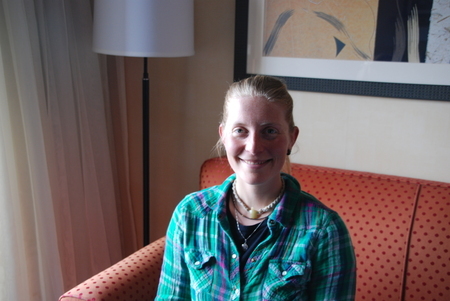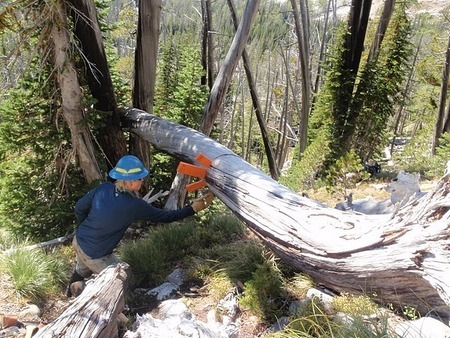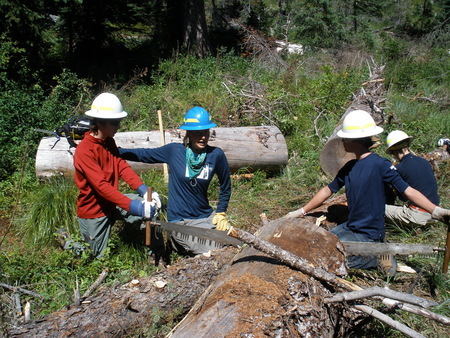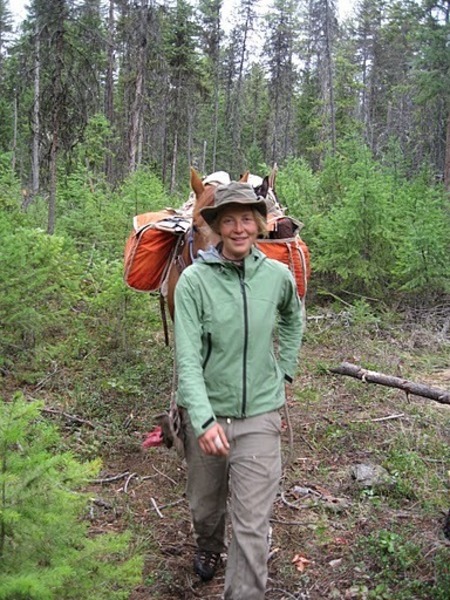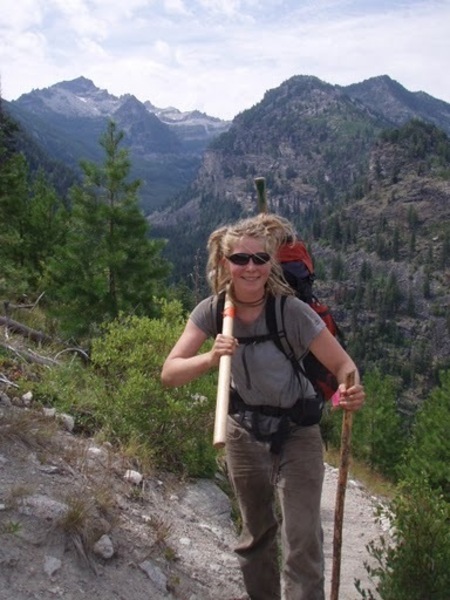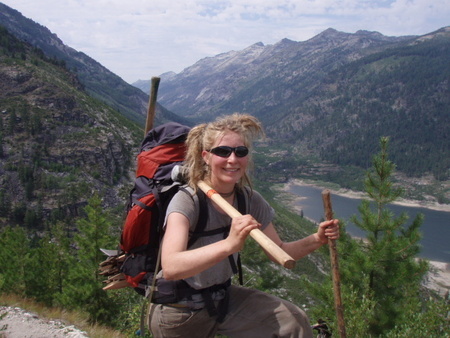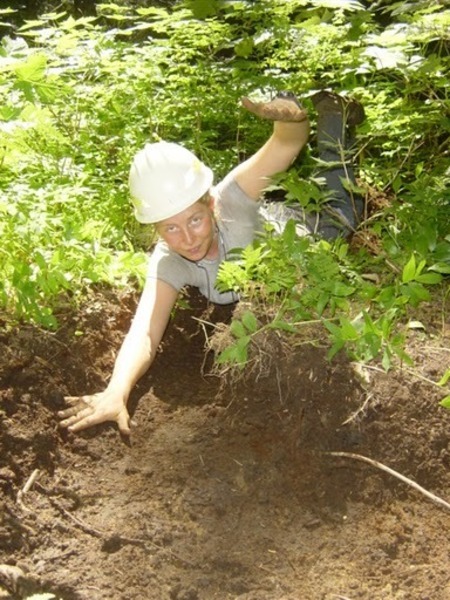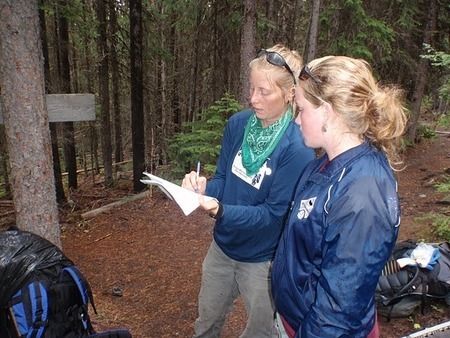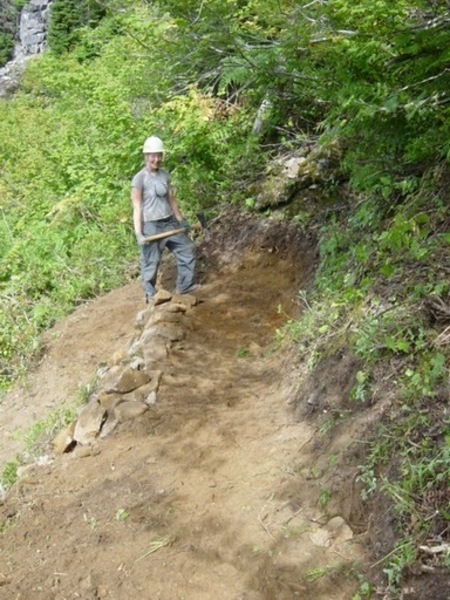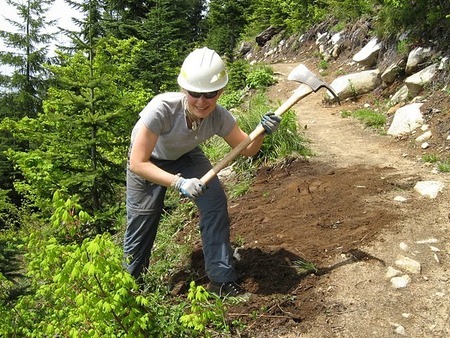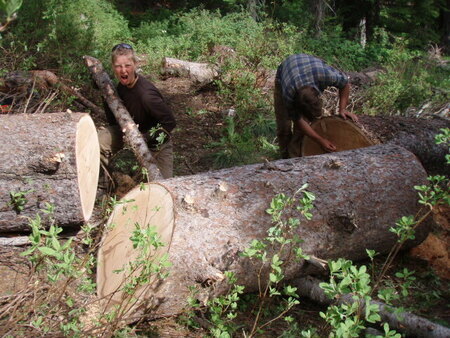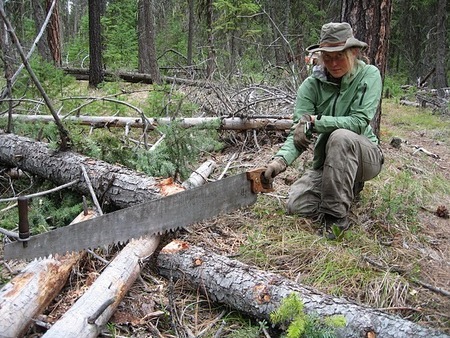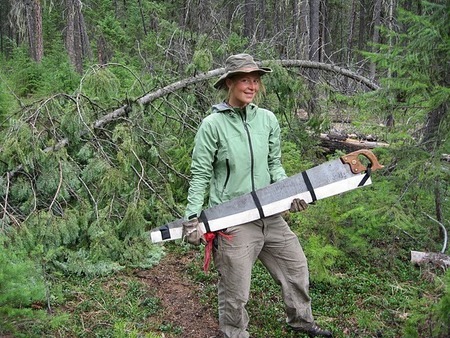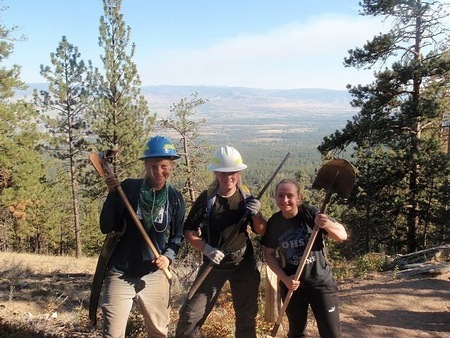Episode 9 : Women in Wilderness : an interview with Rachel Kaufman Item Info
In this episode, titled “Women in Wilderness,” we hear from Rachel Kaufman, a third generation Montanan, who grew up enjoying the recreational opportunities that wilderness offers. Rachel graduated from the University of Montana with a B. S. in Natural Resource Conservation, and she has previously worked as a wilderness ranger in Washington’s Alpine Lakes Wilderness and on wilderness trail crews in the Selway-Bitterroot Wilderness and the Chugach National Forest in Alaska. Rachel decided that she had seen a lot of beautiful places, but nothing was quite like the mountains of Montana. She also felt a little bit of ownership, and felt that she needed to come back and be a part of the conservation effort. In 2010, Rachel got a job with the Bitterroot National Forest on a trail crew, and then from there, she started working for the Selway-Bitterroot Frank Church Foundation during the summer season. As the SBFCF’s web site comments, “Her lively personality and enthusiasm for wilderness stewardship compliment Rachel’s strong wilderness background to make her an effective and engaging wilderness leader. She is thankful for this opportunity to give back to the wild places that she loves and respects so much.”
Episode 9 : Women in Wilderness : an interview with Rachel Kaufman [transcript]
00:00:00:00 - 00:00:29:09 Debbie Lee: Welcome to the Subway Bitterroot Wilderness History Project, which is made possible by a grant from the National Endowment for the Humanities. The University of Idaho, and Washington State University. Part of the project’s mission is to collect, preserve, and make public oral histories documenting the history and people of the subway. Bitterroot wilderness. For more information, please visit our website at SPW lib argue Idaho redo.
00:00:29:12 - 00:00:55:10 Debbie Lee: And then I think people, I think people get so much out of being in a wilderness setting once you take away cars and money and telephones. People are different and they are different to each other, I think. and and then they draw on things in themselves that maybe are a little rusty from our crazy life out here now.
00:00:55:13 - 00:01:25:28 Debbie Lee: I think the ways that people get along when they’re isolated in a place like that, that they place that they want to be, are really it’s a wonderful thing.
00:01:26:00 - 00:01:30:07 Debbie Lee: so you wrote this article in the.
00:01:30:10 - 00:01:31:06 Rachel Kaufman: the Bitterroot star.
00:01:31:07 - 00:01:37:16 Debbie Lee: The Bitterroot star? can you talk about the, the event that caused this article?
00:01:37:17 - 00:02:05:09 Rachel Kaufman: Yeah. So the Solway Bitterroot Foundation and the Montana Wilderness Association kind of started this collaboration, with the the younger members of the Montana Wilderness Association called the Ridge Runners. And the idea was to do, 5 to 6 volunteer projects all day long, volunteer trips throughout the summer. And so, I had found this, the Blodgett Overlook Trail, which is this beautiful.
00:02:05:09 - 00:02:27:09 Rachel Kaufman: It’s about a mile and a half long trail, and it goes up to overlook this, iconic, canyon in the in the Bitterroot. Then there’s a a beautiful, overlook up to an arch. If you look south, there’s, like a natural rock arch. when you’re at the bridge, the Stockbridge, you.
00:02:27:11 - 00:02:28:24 Debbie Lee: Look to those at the top.
00:02:29:00 - 00:02:53:09 Rachel Kaufman: So if you look to the south, next time you do it, there’s a there’s an archway. Okay, so anyway, this is a different trail from the from the canyon trail, but, so my Montana, my Ridge Runner volunteers, it was two gals plus myself. We went up to this trail, and it’s it’s a very steep switchback trail. And so, trail users will often just cut off the switchbacks.
00:02:53:09 - 00:03:19:01 Rachel Kaufman: They’ll just go straight up the switchbacks. And that’s really detrimental to the soil and the ecology of that area. It creates water runs off a lot more quickly. And there’s the erosion is immense, especially on this trail. The erosion is immense. And and the cut off between the switchbacks are 5 to 15ft in some places because they’re, people are just going, going up and spreading their impact.
00:03:19:04 - 00:03:40:25 Rachel Kaufman: And so it’s just it’s really a problem then from there, weeds can infest it’s bare, compacted soil. So native plants aren’t going to seed there as easily as non-native plants. And invasive weeds will come in. So the three of us were on a mission to, we installed some signs, some that said, please stay off these trails, there’s restoration in progress.
00:03:40:25 - 00:04:03:07 Rachel Kaufman: And then a couple more that kind of explained why you shouldn’t cut off switchbacks. Those reasons that I just explained about the weeds and the erosion, etc.. And so we installed three signs. It meant digging big holes, lugging up the lumber, that sort of thing. And then, we also dragged branches and, and tree stumps and, and rocks and whatever we could.
00:04:03:07 - 00:04:27:10 Rachel Kaufman: And we chunked up the cut offs with Pulaski, then shovels, and then blocked off these cut offs with, with major scary looking pieces of wood. So hopefully the idea is that people will stay on the trail. They won’t cut off the switchbacks. And this, you know, I’m hoping that maybe, maybe actually in the next couple of weeks to month, I can go up and seed some native seeds up there.
00:04:27:12 - 00:04:36:19 Rachel Kaufman: That was part of my, you know, if we if we chunk up the soil, we can get rid of some of the compaction that has occurred and maybe seedlings, native seedlings will take place.
00:04:36:22 - 00:04:43:23 Debbie Lee: So, so what’s it like to do a project with all women and no, testosterone on the trail?
00:04:43:26 - 00:05:14:11 Rachel Kaufman: Well, it is, it is really fun. Actually, the two gals that I was working with were really stepped up. And I think when there’s, when when males aren’t involved, I think females step up a little bit more. I mean, there’s always that strength and power there, but often the, the tendency or the habit to defer takes over and without any males around, I mean, these two gals just were hauling the biggest stumps around and, you know, grunting and really feeling their female power.
00:05:14:11 - 00:05:22:27 Rachel Kaufman: And that’s so fun for me to see because, often it’s suppressed. And so this, this all woman trio was great to work with.
00:05:22:27 - 00:05:30:02 Debbie Lee: So can you think of an example when it was suppressed that maybe you observed or that you actually experienced?
00:05:30:03 - 00:06:02:05 Rachel Kaufman: Well, I know myself personally, I kind of I’ve worked on all male crews for a lot of years, and, I’m torn in two different directions. I in one way, I’m definitely, working to prove myself and often overexerting myself. But on the other hand, I guess I feel I feel compelled to, admit the fact that I’m not as physically strong to everybody.
00:06:02:07 - 00:06:26:19 Rachel Kaufman: And, then that’s not necessary. All that fun. But it’s also good to recognize. Okay, well, maybe maybe I’m not as physically strong, but, I know how to use teamwork and collaboration in the manner to accomplish the exact same thing. Or, you know, my my problem solving skills might be more tuned because I can’t just use brute force, and that sort of thing.
00:06:26:26 - 00:06:37:03 Debbie Lee: Have you met any women on the, subway Bitterroot Wilderness area that you maybe look up to as a role model?
00:06:37:04 - 00:06:57:22 Rachel Kaufman: Definitely. Yeah. There’s, I worked with a gal, with the Forest Service, who she was also on my crew, and she’d been doing, trail crew type things for ten years. And she had an amazing eye for how to use a crosscut and how to use the cross cut with the least amount of effort to make the most efficient cuts.
00:06:57:22 - 00:07:22:18 Rachel Kaufman: And she was knew so much about the trade, it was amazing. And then, there’s some other women on the national forest that are wilderness rangers and the wilderness manager. There. They’re all, you know, good good horsemen, good backcountry stewards, awesome. With teaching people, how to do leave No Trace and that sort of thing. So definitely have quite a few role models, I guess.
00:07:22:21 - 00:07:23:15 Rachel Kaufman: 3 or 4.
00:07:23:21 - 00:07:41:02 Debbie Lee: That’s cool. Now, you have taken a couple of solo trips. Yeah. Can you talk about hiking solo? Because I know some people, are afraid to hike, so especially women. So, yeah, I talk about 1 or 2 of those trips.
00:07:41:02 - 00:08:07:00 Rachel Kaufman: Yeah. so I’ve done, this past fall, I was doing some work for the Forest Service where they they’d had a wilderness ranger who was gone, and he was, just his his work load needed to be done. And so they asked me to do it, and I did that through the foundation, and, it involved, inspecting some outfitter camps because it was in the fall.
00:08:07:00 - 00:08:27:18 Rachel Kaufman: And so these outfitters had, set up their camps and they need to follow certain regulations in the wilderness that that have to do with impact and, and usage and that sort of thing. And so there’s a whole system of checking off if they’re doing the right sorts of things. and this was actually in the Frankfurt’s wilderness, the River of No Return wilderness.
00:08:27:20 - 00:08:52:17 Rachel Kaufman: And, and so I was hiking maybe 15 miles a day to get to these remote campsites. And I was doing it by myself. And it’s and it’s interesting. I’ve done some hiking by myself, for shorter periods of time, but these were, 5 to 6 days in some cases, which is really, an interesting opportunity to be reflective.
00:08:52:19 - 00:09:18:05 Rachel Kaufman: That’s one thing. and I definitely do some things different when I’m backpacking by myself. And, and one of those is that I bring, a little MP3 player because I am a little bit scared of the noises that go bump in the night when I’m trying to fall asleep. Earplugs don’t necessarily cut it. And so I like to listen to the music to help me fall asleep.
00:09:18:07 - 00:09:46:28 Rachel Kaufman: And, in the past, I think, like when I was 18 or 19, I would have completely pooed that idea. I would have been, you can’t have it. You can’t bring something like that into the wilderness. But, or even into the outdoors just, you know, enjoy the noises. But I’d have I’ve had enough sleepless nights that I would just kind of resigned to the MP3 player and, and in fact, I discovered that it was sort of nice to hike to, actually, it had, has an external speaker.
00:09:46:28 - 00:10:16:06 Rachel Kaufman: So I could, when I was feeling a little bit lonely or had a song stuck in my head that I was tired of. Because that happens when you’re by yourself. You just get one line over and over from the most annoying song you can imagine. And so that served to eradicate the, the annoying song. I had, some kind of creepy experience since I was never really necessarily scared.
00:10:16:09 - 00:10:36:04 Rachel Kaufman: you get into your routines when you’re by yourself, which is very interesting, and you kind of have to remember to take time and not do it all at once, because it’s very easy to get done hiking, cook your dinner, and then crawl into bed. But then you’re in bed at 4:00 and that’s or 530 or whatever, 6:00 maybe.
00:10:36:07 - 00:11:02:12 Rachel Kaufman: and so I really enjoyed finding ways to not rush through the things that you’re used to doing, like cooking and setting up your tent and going to bed. And so I took a lot of walks in kind of evening time and where when you’re with someone, you might be sitting around the campfire or you might be socializing some way and in this case, I was kind of exploring the campsite a little bit more.
00:11:02:14 - 00:11:25:23 Rachel Kaufman: But that evening, I awoke to a tree falling, like wrote to the crash of a tree falling. And so that was, and I always, when I’m setting up a camp work, because I mentioned before, I’ve had a tree fall in the middle of a campsite before, and so, I that was another moment where you’re like, Holy crap, but you can’t really say it to anyone, so you just lay awake instead.
00:11:25:26 - 00:11:32:15 Debbie Lee: When you made your, solo trip to Tim Camp and clearly you encountered a cabin or not, what happened there?
00:11:32:15 - 00:11:51:21 Rachel Kaufman: Right. So, this was, campsite monitoring trip that I went on, and I, I take, photocopies of past inventories that Wilderness Rangers have made from the 70s on to kind of help or help me as a rubric. Well, what was it? What did it look like five years ago? The campsites are supposed to be monitored every five years.
00:11:51:21 - 00:12:15:23 Rachel Kaufman: So what am I looking for? What landmarks am I looking for? How do I find this campsite? And then I’ll make a little map of it. And so one of the campsites that I was looking for, the, inventory, described it as being a ways off the trail. following a little social trail. And there would be, the remains of a cabin there and, or there was a cabin there, I think is what, what it said something along those lines.
00:12:15:23 - 00:12:37:11 Rachel Kaufman: And so I just spent a ton of time looking for it. I really wanted to see this whole cabin, and I never found it. I didn’t find a trail. I didn’t find the remains. Nothing like that. But I got back and I talked to the the wilderness ranger who had actually written up this old inventory, and she said, well, you know, this cabin actually has was built by the Curley family.
00:12:37:13 - 00:13:03:18 Rachel Kaufman: The Curley family is I mean, this is at Curley Creek, Curley Lake, and now there’s this. I didn’t know that there was a Curley family who had a cabin. And so that was very interesting. She said, up until around 10 or 15 years ago, the cabin was being used by the Curley family. And, at some point that use came to an end and, and she and her coworker actually went and dismantled and burned the cabin.
00:13:03:21 - 00:13:28:26 Rachel Kaufman: And so this is just an example of how recent history can be. And I was actually pretty disappointed that I hadn’t been able to find the remains of the cabin and and see what someone had built back in the forest. But very interesting. and then she also told me that, the Curley family still lives in the Valley and are still alive.
00:13:29:02 - 00:13:39:29 Rachel Kaufman: So, I mean, it’s living history. Yes, it’s very cool. I mean, it’s just history can be last year even, and it still has that impact on you.
00:13:39:29 - 00:13:40:13 Debbie Lee: Yeah.
00:13:40:13 - 00:13:43:20 Rachel Kaufman: That’s right.
00:13:43:22 - 00:14:10:24 Debbie Lee: Thank you for joining us for this episode of the Selway Bitterroot Wilderness History Project, which has been made possible by the National Endowment for the Humanities, the University of Idaho, and Washington State University. The project coordinator is Debbie Lee, recorded and produced by Aaron Jepson.
Gallery
- Title:
- Episode 9 : Women in Wilderness : an interview with Rachel Kaufman
- Creator:
- Debbie Lee; Rachel Kaufman
- Date Created (ISO Standard):
- 2011-04-20
- Description:
- Interviewee: Rachel Kaufman | Interviewer: Debbie Lee | Location: Missoula, Montana Date: April 20, 2011 | In this episode, titled 'Women in Wilderness,' we hear from Rachel Kaufman, a third generation Montanan, who grew up enjoying the recreational opportunities that wilderness offers.
- Subjects:
- podcasts women conservation personal recollections recreation
- Section:
- Wilderness Voices
- Location:
- Selway-Bitterroot Wilderness (Idaho and Mont.)
- Publisher:
- Wilderness Voices, The Selway-Bitteroot Wilderness History Project, https://selwaybitterrootproject.wordpress.com/
- Original URL:
- https://selwaybitterrootproject.wordpress.com/2011/07/12/women-in-wilderness/
- Source Identifier:
- Selway-Podcast-ep9
- Type:
- Sound
- Format:
- audio/mp3
- Language:
- eng
- Preferred Citation:
- "Episode 9 : Women in Wilderness : an interview with Rachel Kaufman", The Selway-Bitterroot Wilderness History Project, University of Idaho Library Digital Collections, https://www.lib.uidaho.edu/digital/sbw/items/sbw291.html
- Rights:
- Copyright: The Selway-Bitteroot Wilderness History Project. In Copyright - Educational Use Permitted. For more information, please contact University of Idaho Library Special Collections and Archives Department at libspec@uidaho.edu.
- Standardized Rights:
- http://rightsstatements.org/vocab/InC-EDU/1.0/

